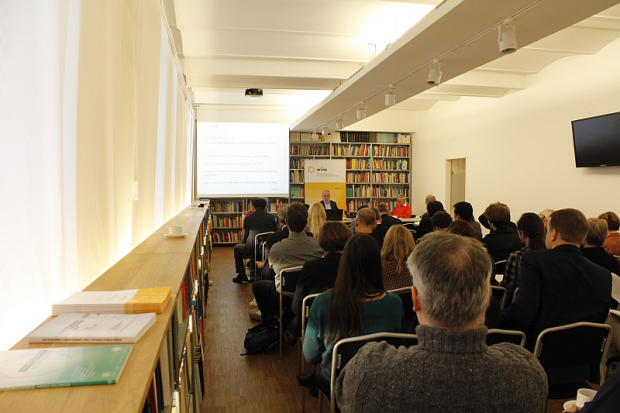CESEE in 2017-2019: back on track to convergence
09 November 2017
In our Autumn Forecast we revised up our expectations for growth across EU-CEE. For the Western Balkans, the CIS and Ukraine, the trends are generally less positive.
- On November 9th, Economist Peter Havlik presented wiiw's new Autumn Forecast report, with projections for 22 countries in Central, East and Southeastern Europe (CESEE) up to 2019.
- GDP forecasts for 2017 have been revised upwards for all Central and East European EU Member States (EU-CEE).
- Farther east, especially in Russia, but also in the Western Balkans, the post-crisis recovery has been much weaker.
- Private consumption is the main growth driver, underpinned by rising wages and household incomes.
- Nonetheless, CESEE labour cost competitiveness is not yet endangered.
- Gradually, along with expanding private consumption, investments have also gained strength and have increasingly emerged as a driver of growth.
- Trade balances have improved, and many EU-CEE countries (as well as Russia) also report current account surpluses.
- Growth is thus becoming broader based, more robust, and probably also more sustainable.
- Improvements in labour markets are spectacular, with rising employment levels mirrored by declining unemployment.
- Simultaneously, emerging labour shortages are acting as a potential constraint on future growth.
In terms of current GDP growth prospects, the CESEE region is split into three sub-regions: the EU-CEE, with average annual growth close to 4% in the forecasting period; the Western Balkans, with GDP growing by around 3% per year; and finally, the Commonwealth of Independent States (CIS) and Ukraine, where growth will be around 2% annually in the medium term. The EU-CEE region is thus catching up again with Western Europe, and the process of economic convergence has resumed at a greater pace than previously expected. This catching-up process will continue probably for the rest of the decade. Importantly, economic convergence is not expected to resume in Russia, where the lack of structural change, lasting investment climate deficiencies and geopolitical conflicts impose a burden on growth. Meagre growth in Russia adversely affects the growth prospects of her CIS partners. But there are several other CESEE countries where recent political developments are not very conducive to growth and European integration in the medium term. However, for the moment, economic growth seems to be unaffected by domestic political instability. Globally, economic resilience persists, regardless of the elevated geopolitical risks.

press conference at wiiw. photo: wiiw/Ronald Hartwig, CC-BY-SA 4.0
The Forecast Report also includes three special topics (on income convergence with Western Europe, on euro accession and on higher yields on hard currency sovereign debt in CESEE). The key findings of these reports are:
- Convergence in terms of per capita GDP levels in CESEE is a long-term process; during the next decade, no country in the region will catch up with average EU-28 wealth levels, and advanced EU-CEE countries like Poland and Hungary will not even reach the 80% mark.
- Despite sustained criticism since its inception, the euro may yet survive and attract new members in the EU-CEE; it is in the interests of Croatia and Bulgaria to join, and is potentially advantageous for Hungary and Poland; the case is less clear cut for the Czech Republic and Romania, although in neither case would accession be harmful.
- Many CESEE sovereigns are not in a markedly better shape to deal with a sharp rise in debt yields than they were 10 years ago, and in some cases they are in a worse position; for countries with heavy debt loads and little apparent prospect of achieving high and sustained growth, bond markets could panic, leading to funding difficulties; Ukraine stands out as particularly vulnerable from a sovereign risk perspective, while we conclude that Belarus and many countries in the Western Balkans are also in a weak position.
Press Releases
Related Presentations
- MOSOEL wieder auf Konvergenzkurs (press conference presentation in German)
- CESEE Region Back on Track to Convergence (press conference presentation in English)
